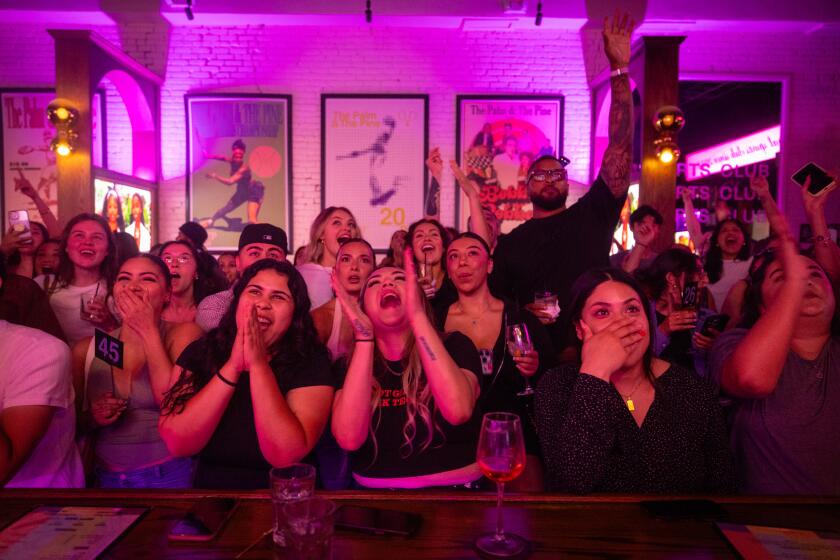Tijuana killings may signal fall of Arellano Felix cartel
- Share via
TIJUANA — The birthplace of one of Mexico’s most infamous drug cartels looks more and more like its graveyard. Gunmen and associates of the Arellano Felix cartel, rulers of the city’s criminal underworld for two decades, are being massacred by the score.
Their mangled bodies turn up in garbage-strewn lots, a dozen at a time. Killers cut out their tongues, slice off heads, and leave behind taunting messages. Two barrels of industrial acid left on a sidewalk last week are believed to contain liquefied human remains.
In all, at least 57 suspected organized crime members, a majority of them believed to be part of the Arellano Felix organization, were killed in the last week, including 12 dumped in front of an elementary school Sept. 29 and eight tossed in an industrial yard Thursday.
The carnage may be a sign that the cartel named for the Arellano Felix brothers is fractured and vulnerable to contenders, inside and outside the organization, who are looking to get control of lucrative trafficking routes into the United States, according to law enforcement sources.
Several forces have converged on the trafficking organization. The U.S. government has dedicated tens of millions of dollars over two decades to combating trafficking across the border with Baja California. The Mexican government also has intensified its efforts aimed at the cartel, which has splintered. Rival cartels have attacked, announcing their arrival with the savage killings and banners unfurled across busy intersections.
“El Mayo and El Chapo are the ones trying to enter Tijuana,” read one banner, referring to alleged trafficker Ismael Zambada, and Mexico’s most-wanted man, Joaquin “El Chapo” Guzman, leader of the Sinaloa cartel.
“We are now seeing the tail end” of the Arellano Felix organization, said John Kirby, a former federal prosecutor in San Diego who co-wrote indictments against several members of the organization. “They’re losing what was left of their grip on Baja California.”
Elements survive
Not so fast, others warn. Elements of the organization, which earned its ruthless reputation by turning back all challengers, remain very much alive. Some of its deadliest assassins still roam the region. Its reputed leader, Fernando Sanchez Arellano, nicknamed El Ingeniero, a nephew of the group’s founders, is believed to have a large war chest. The organization retains strong ties to law enforcement. And a contender for control has emerged from within the Arellano Felix organization.
“Old cartels don’t seem to go away; they just seem to morph into new variants over time,” said David Shirk, director of the Trans-Border Institute at the University of San Diego. “There’s strong continuity for these organizations, dating back multiple generations of smugglers.”
The cartel came to power in the 1980s when Colombian cocaine barons, shut out of traditional trafficking routes across the Caribbean Sea into Florida, began partnering with Mexican crime groups.
The Arellano Felix brothers -- Benjamin, Ramon, Javier -- moved in from Sinaloa and provided the perfect springboard. From their Tijuana stronghold, they controlled trafficking routes into California, the biggest drug market in a country that is the biggest consumer of cocaine in the world.
By the 1990s, the brothers were smuggling tons of cocaine into the U.S., mostly through the crossing at Mexicali, and killing anyone in their way. Authorities believe they killed hundreds, including prosecutors, police and judges.
The cartel suffered its biggest blows in 2002, when Ramon was gunned down by police in Mazatlan. With the feared enforcer out of the way, Mexican authorities weeks later arrested his brother Benjamin, the reputed brains of the organization.
Javier, often likened by authorities to the inept Fredo Corleone of “The Godfather” film clan, managed to keep the cartel together with the help of brutal and loyal lieutenants.
But after his 2006 arrest on a boat off Baja California, one associate after another began to fall. Gustavo Rivera, an alleged top lieutenant, was arrested outside a hot dog stand in Cabo San Lucas in March. Days later, Saul Montes, identified by authorities as an enforcer, was pulled out of his car by police at the Baja 250 off-road race. In August, another reputed enforcer, Ruben Rios Estrada, nicknamed El Pit, was dragged away from the bingo tables at a local casino by federal agents.
The cartel’s leadership is said to have passed to Sanchez Arellano, the son of an Arellano Felix sister. Not much is known about Sanchez Arellano and it’s unclear whether Mexican authorities even know what he looks like. They have not released a photo, as they commonly do for drug suspects.
Sanchez Arellano’s attempts at reviving the family legacy have been blocked by his chief rival, Teodoro Garcia Simental, nicknamed El Teo, a former cartel lieutenant who broke off earlier this year, according to law enforcement authorities.
Garcia often is blamed for the spate of abductions over the last few years, which have turned the city into one of the kidnapping capitals of the world. By April, the medical community, led by physicians who had been held for ransom, was threatening to stop treating patients in Tijuana.
Sanchez Arellano demanded a halt or cutback in the kidnappings because they were bringing down too much heat on the organization, according to Mexican media reports confirmed by Mexican law enforcement authorities.
Garcia allegedly refused, leading to an April gun battle between the rival groups that left 15 gunmen dead. Garcia fled to Sinaloa after the shooting. Tijuana enjoyed a relatively peaceful early summer.
Then in late August, four decapitated bodies were found in an empty lot. Their heads, charred from gasoline burns, were left at their feet, along with a message, “We are people of the weakened Engineer,” referring to Sanchez Arellano.
Killing field
Since then, Tijuana has turned into a killing field of burned, decapitated and mangled bodies, many bearing similar messages.
“I think Teo’s back, with a vengeance,” said one U.S. federal anti-drug official who spoke on condition of anonymity because he is not authorized to speak with the media.
Garcia’s fierce offensive suggests that he has formed alliances with outside organized crime groups, possibly the Sinaloa cartel. The powerful Gulf cartel also could be operating in the city, said Martin Rubio, the Mexican federal attorney general’s top official in Baja California, who said the beheadings were the telltale signatures of the Texas-based organization.
The main battle for now appears to be between the cartel leader and the renegade lieutenant. Sanchez Arellano is said to control the coastal area; Garcia, the sprawling eastern part of the city. Each leader has an army of about 100 gunmen who roam in convoys of SUVs, according to the U.S. anti-drug official.
If Sanchez Arellano claims the intimidating pedigree, Garcia boasts the fiercer reputation. One of his top enforcers, Raydel Rosalio Lopez, is nicknamed Crutches because he has left so many of his victims disabled.
They’re apparently the lucky ones.
Police found eight more bodies Friday. Two had been decapitated, their tongues cut out and their heads placed atop their torsos. The killers left behind another message, according to the Baja California attorney general’s office.
“Here you go Engineer,” wrote the killers.
More to Read
Sign up for The Wild
We’ll help you find the best places to hike, bike and run, as well as the perfect silent spots for meditation and yoga.
You may occasionally receive promotional content from the Los Angeles Times.







